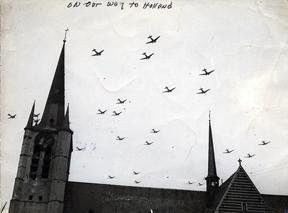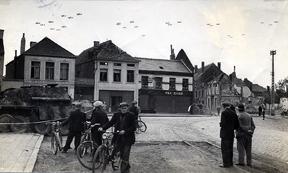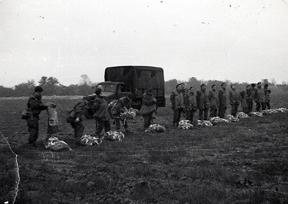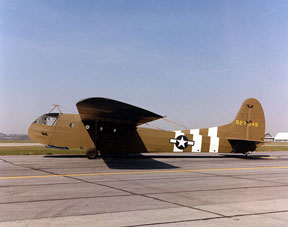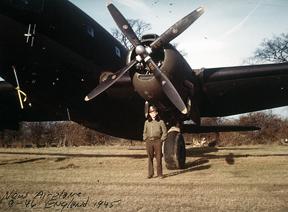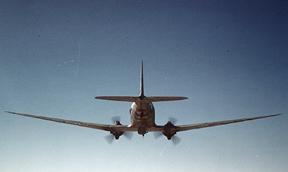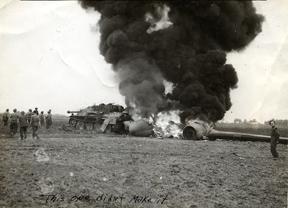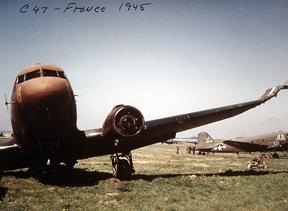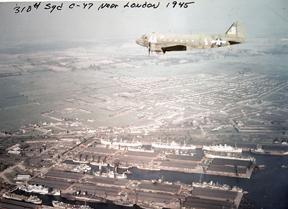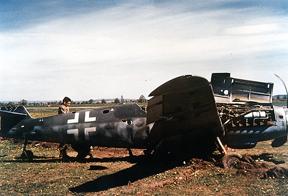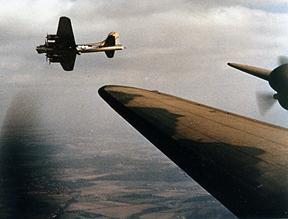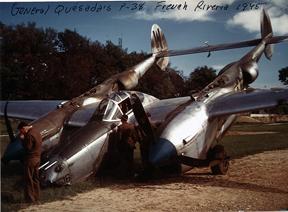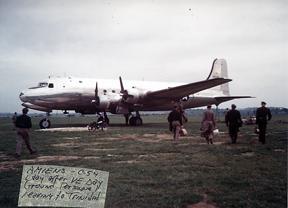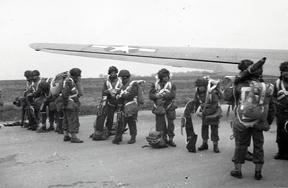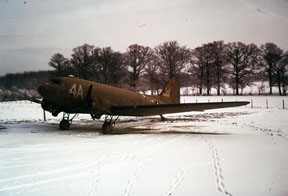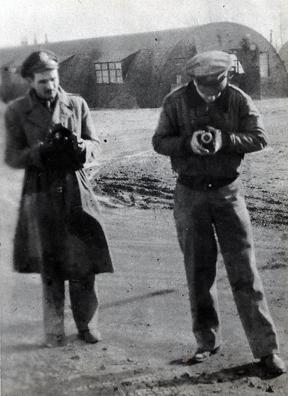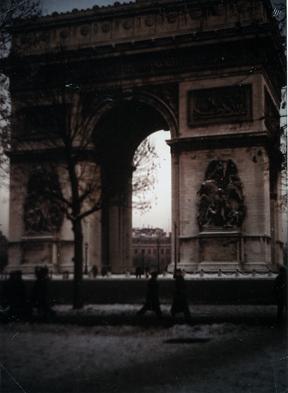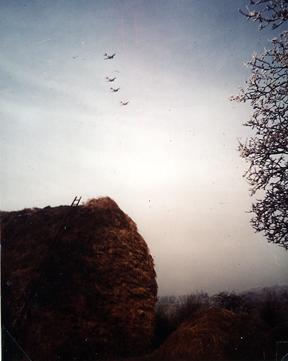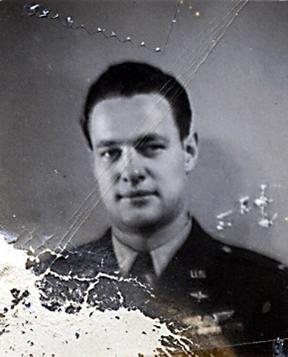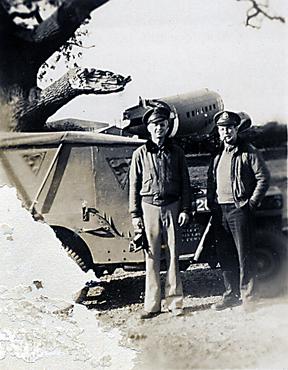|
MARKET GARDEN
by Aubrey L. Ross
Lieutenant Colonel, USAF Retired
|
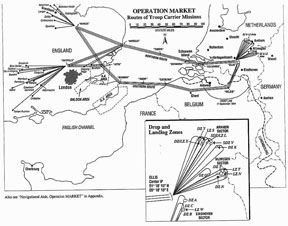 Click image for a larger view RECOMMENDED!
It will open in another window so you can keep it open while reading.
Click image for a larger view RECOMMENDED!
It will open in another window so you can keep it open while reading.
Map of routes and
zones |
| Editor's Note: After
the initial, and slightly surprising, success of the landings at
Normandy, the Allies hoped for a steady push across France –
maybe even home by Christmas. What, sadly, happened was that the
Allies bogged down in a virtual stalemate. In August, British Field
Marshal Bernard Montgomery pushed hard for what a later American
general would call a "Hail Mary." He wanted to make an
end-run around the battle through northern France, the low countries,
and into the industrial heartland of Germany, the Ruhr. The largest
airborne drop in history (to that date) was made to capture and
hold three strategic and a few smaller bridges until the mass of
land forces could arrive. All went well except for a minor little
detail lost to Allied intelligence . . . the II SS Panzer Corps.
Here is the story from one who was there! |
|
In
early September 1944, a decision was made by Supreme Allied Headquarters
to drop an airborne force in Holland. The objective of this ill
conceived debacle was to capture several key bridges, one crossing
the Rhine river near Arnhem, and hold them for the advancing troops
that were inching slowly toward Germany. This operation was code
named MARKET GARDEN, and was not canceled, as many of us would
wish later. The book A Bridge Too Far tells this story far better
than any that I have read. Our mission in Operation MARKET was
to transport airborne forces to the Arnhem-Nijmegan area of Holland.
Once on the ground, these forces were to seize and hold vital
bridges until relieved by the British Second Army driving north
through Eindhoven. The routes to the drop zones were planned so
as to avoid most of the heavy antiaircraft fire. However, it was
known that both heavy and light antiaircraft guns were in the
Arnhem and Nijmegan areas and at the landfall point at Schouwen
Island.
|
|
|
|
We did not do any specific
training for this mission nor was there a dress rehearsal. We
were very happy to learn once again that our group would not have
to tow gliders on this mission. This chore fell to one of the
less fortunate groups.
No Troop Carrier pilot ever wanted to tow gliders especially into
combat. A normal cruise speed for the C-47 was 145 to 155 MPH,
but with a glider you would be slowed to 90 to 95 MPH with increased
power. It was also much more work for a pilot when a glider was
in tow with airspeed hovering near stalling speed.
|
|
On
September 14, 1944, we, once again, had "Guests" move
onto our base, the 504th Parachute Infantry Regiment (PIR), 82nd
Airborne Division. At the first mission briefing, we learned that
the 315th's first destination was Drop Zone "O," located
about three miles southwest of Nijmegan and one-half mile north
of the Maas River. Two serials of 45 aircraft each were to be
used to transport 1240 paratroopers and 473 parapacks. Our route
to the target was to the east coast of England at Aldeburg, then
94 miles across the North Sea to Schouwen Island in Holland. From
Schouwen Island, it was approximately 90 miles to the drop area.
On the morning of the first MARKET mission, hundreds of Allied
bombers and fighters dropped more than 3000 tons of fragmentation
bombs on the suspected antiaircraft sites along the troop carrier
route.
|
|
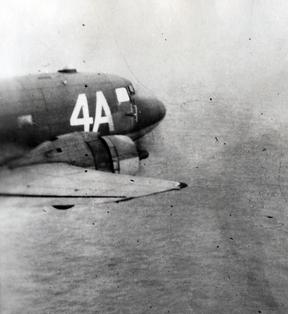
Click image for a larger
view
310 Sqd. C-47 Over England 1944
|
On
Sunday, September 17, 1944, at 1039 hours, 90 aircraft began taking
off from Spanhoe Airfield loaded with members of the 504th (PIR),
82nd Airborne Division, bound for Holland on a mission that was
designed to shorten the war. The first serial of 45 planes was
led by Lt. Col. Dekin and the second was led by Lt. Col. Gibbons.
We formed the usual V of V's formation and joined a stream of
troop carrier traffic moving toward the coast of Holland. Shortly
after passing the Dutch coast, we encountered fire from antiaircraft
batteries along our route. Just past the coast, the 34th Squadron's
C-47 no.308, piloted by Captain R. E. Bohannan, was hit by flack.
The left engine and one of the underslung parapacks (parapacks
are large cylinders containing supplies slung under the belly
of the airplane) began to burn and he went down near Postbahn
van den Stadscherdike at Fifnaart. The crew chief along with 15
paratroopers parachuted to safety, but they were soon captured
by the Germans. Most of these men were wounded. Capt. Bohannan,
Lieutenants. Felber and Martinson, and S/Sgt Epperson were killed.
In a rare quiet moment, my copilot doing
the flying, I stared out the windscreen and reflected . . .
|
Flashback to May 1943
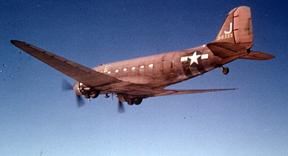
Click image for a larger view
One of our C-47s
Over Clouds |
It was May 28, 1943, one
of the happiest days of my life for I had successfully completed
pilot training satisfying a dream from early childhood and also
receiving a commission as a second lieutenant in Army Air Forces.
My euphoria was short lived when I saw my assignment orders were
not for a fighter squadron but read for Troop Carrier command which
I had never heard of . . . I knew that the needs of the service
come first so I was on my way to Bergstrom Air Base in Austin, TX.
Here we trained in the military version of the twin engine Douglas
DC-3, the mainstay of most airlines during the 1930s and 1940s.
The military made some modifications and designated it the C-47
(affectionately known as the "Gooney |
| Bird")
but it was still a slow, unarmed transport with no armor plate nor
self-sealing fuel tanks. This was the airplane used by Troop Carrier
during the war. We did receive, during the summer
of 1944, a few of the new Curtis C-46 aircraft which was faster
and |
|
|
carried a larger
load. Also about the same time 2 B-24 Liberator bombers
with all armaments removed and replaced with fuel tanks were
received by each squadron. This airplane was designated the C-109
and was used primarily to supply Patton's army with gasoline during
his dash through Europe. This was a flying gas tank as it was capable
of carrying more than 2900 gallons of gasoline. Crews on the C-109
didn't carry matches or cigarette lighters or anything that might
ignite the gasoline fumes. |
|
| There
were also a large number of Waco CG-4A gliders in the Troop Carrier
inventory. After a few hours of
training in the C-47, I received orders for overseas. I departed
in September 1943 with an inexperienced crew bound for North Africa
flying the C-47 |
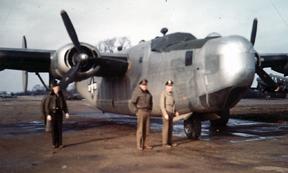
Click image for a larger view
Spanhoe C-109 Tanker In Our Squadron |
across the North Atlantic
route. We left the US from Presque Isle, Maine. From there on to
Goose Bay Labrador, then to Greenland, next to Iceland, then on
to Scotland, then Southern England where we leaped off for Casablanca.
From there I went to my assignment in Sicily with the 62nd Troop
Carrier group. We hauled freight, carried passengers (some VIPs
such as Churchill), evacuated wounded from the front as well as
dropping paratroops when the need arose. We also flew supplies into
Yugoslavia, Albania and Greece to Tito's troops who were giving
the Germans a hard time in the Balkans.
In March 1944, volunteers were sought to
transfer to England to train for
the invasion of Europe, I was one of the
first to volunteer because our living conditions |
were so bad and I knew things had to be better
in the England. Upon arrival in the United Kingdom, I became a member
of the 310th Troop Carrier squadron, in 315th Troop Carrier group at Spanhoe
airdrome about 80 miles north of London. Several missions were flown dropping
paratroops on D-Day without significant losses, but it a different story
in operation MARKET GARDEN as follows.
Back to being shot at
The ground fire increased as we neared the
drop zone and seven of our aircraft were hit before we reached the drop
zone even though fighters were keeping the pressure on the gun batteries
all the time. Most of the planes dropped their troops on or near the
drop zone. As soon as the last man cleared the plane, we would dive
to the deck to provide a lesser target and avoid the heavy ground fire.
|
On
D-Day plus one, September 18, 1944, two serials of 27 planes each
left Spanhoe to drop the troops of the British 4th Parachute Brigade
on Drop Zone "Y," northwest of Arnhem. On this day,
eleven aircraft were damaged and two were shot down before reaching
the drop zone. Lt. Tucker's plane (34th Squadron) was hit and
began burning 16 miles short of the target. All bailed out and
four days later Tucker and his crew of Lt. D. O. Snowden, T/Sgt.
W. W. Durbin, and S/Sgt. W. E. Hewett, returned having evaded
capture. The paratroopers landed near Bennekon, Holland. Lt. Spurrier's
plane, flying on the right wing of 43rd Squadron Commander, Lt.
Col. Peterson, began burning near Herrogenlosch. We later learned
that when the crew chief, Cpl. Russell Smith saw
|
|
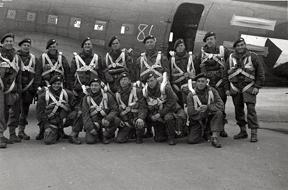
Click image for a
larger view
Spanhoe 1944 Preparing for Drop |
the fire inside the front
of the aircraft and when he received no response from the pilot's
compartment on the intercom, he ordered the troops to jump and he
and the radio operator followed, jumping at a very low altitude.
They all landed near Opheusden, between the Waal and Rhine rivers.
Lt. Spurrier was unconscious and unable to jump so Lt. Edward Fulmer,
the copilot, saw an open field, and crash landed the airplane in
an attempt to save Lt Spurrier. The plan's wing struck a power line
tower, slid along the ground, and exploded in flames. Lt. Fulmer
was able to escape through a side window. Lt. Spurrier and Cpl.
Hollis, radio operator, died of their injuries. Cpl. Smith was hidden
by the Dutch underground for several weeks and was later turned
over to an American unit. He was immediately sent back to the U.
S. because the policy was to transfer any airman who had come in
contact with the underground to another theater. |
|
I
experienced a close call while dropping those British troops at
Arnhem on September 18. I was leading a flight. There were two
planes flying formation with me, one on each wing. As we approached
the drop zone, we encountered heavy ground fire. Looking out either
side of the plane you could see large black explosions, some seemed
just inches from the wings of the airplane. As I began dropping
the paratroopers, a shell came through the open door (the rear
door was removed for drops) and hit one of the British paratroopers
seriously injuring his left arm. The crew chief pulled him aside
and all of the others jumped. As normal procedure, just as soon
as all troops had cleared the plane, I dove for the deck to make
us a more difficult target for the Germans. About this time the
crew chief informed me that we had a wounded paratrooper in the
back. I sent my copilot back to the rear of the airplane to administer
first aid. He came back a short time later and, said that he couldn't
do anything; the sight of blood made him sick. I was
|
|
very upset and angry with him. After a few of
my favorite curse words, I asked him sarcastically if he thought he could
fly the airplane for a short time without getting sick. I gave the controls
over telling him what heading and altitude to maintain, and I went
|
|
back to see if I could
aid the injured man. This was the first opportunity I had to practice
the first aid training given us in school. The poor guy was in
shock, with his left arm hanging by a thin piece of skin almost
completely severed at the elbow, and blood was squirting out of
the blood vessels. With the help of other crew members, I tied
a tourniquet around the upper arm to slow the bleeding, administered
a shot of Novocain, bandaged to keep the arm together, treated
him for shock, then went back to the cockpit and headed for home
on the most direct route. I wish I had followed up on the outcome
of this trooper's treatment, because it appeared to me that he
would lose his arm. Our airplane was only hit by this one shell
that entered through the open door.
The 315th was not scheduled on September, 19, and all Troop Carrier
Wing missions were canceled because of poor flying weather. We
did fly on D plus 4
|
even though the weather was very marginal with
visibility down to less than two miles and cloud layers from 200 feet
to 9000 feet. The precarious position of the British troops engaged in
a fierce battle at Arnhem dictated the urgency of this mission. The troops
to be airlifted were those of the Polish Parachute Brigade.
|
The
first serial of 27 aircraft left Spanhoe at 1310 hours. Because
of limited visibility, instructions were issued to assemble at
1500 feet, an altitude above the haze layer. This serial was composed
of planes from the 43rd and 34th squadrons. The planes were never
able to form so all but two returned to the base. Two pilots broke
into the clear and tacked into a formation from the 314th group
Troop Carrier Group.
The second 27 planes from the 309th and 310th squadrons (The 310th
was the squadron to which I was assigned), led by Lt. Col. Stark
began taking off from Spanhoe at 1427 hours. Two planes from this
serial came back because of weather while the rest of us climbed
through the overcast to above 10,000 feet, where we were able
to assemble above the clouds. Looking back now I am
|
|
amazed that we didn't have more midair collisions
than we did with that many airplanes climbing through the overcast to
form on top. The formation remained at this altitude until over the Belgian
coast where the clouds began to thin, and a gradual let down was begun.
We descended to 1500 feet and made our way to Driel, some two miles southwest
of Arnhem. The drop zone was reached at 1700 hours and we encountered
considerable flak and a number of airplanes were hit, but, in spite of
the flak, all planes dropped their loads of Polish troopers. The heavily
burdened Polish troops took longer to clear the airplanes than was estimated.
This
|
|
prevented the formation from
turning as soon as planned, and as a result, when we did complete
our turn, we were over the town of Elst and severe flak. As usual,
we dove to get as close to the ground as possible to avoid the German
flak. Five airplanes were shot down and several others landed at
nearby air strips because of severe damage.
Lt. Col. Stark was hit in the chest by
shell fragments. He felt certain that the flak vest he was wearing
saved his life. A friend and fellow pilot of mine from the 310th,
Lt. Kenneth Wakley was shot down in plane number 612. Lt. Bruce
Borth, copilot, Lt. M. C. Beerman, navigator, T/Sgt. Magnus, crew
chief, and S/Sgt. Carl Javorsky, radio operator, were killed as
well as Lt. Wakely.
Approaching the DZ, another 310th pilot
and friend, Lt. Cecil Dawkins, was |
wounded in the face and head when his plane took
two flak bursts. With one of the fuel
tanks in port wing burning and flames sweeping down the left side of the
fuselage, Lt. Dawkins moved his plane out of formation, dropped his troops,
and then ordered his crew to bail out. Lt. Cleon Worley (Moose), one of
my roommates, was flying copilot on this mission with Dawkins (At the
last
|
minute
the regular copilot became ill), so Moose volunteered to go in
his place. Lt. Worley, (Moose as all of us called him) was an
old timer having come up with the group of us from Italy and had
been a first pilot and flight leader for some time, so it was
most unusual for him to be a copilot. Moose along with Lt. J.
R. Wilson, navigator, S/Sgt. W. O. White, crew chief, and S/Sgt.
J. Ludwig landed safely and made their escape with the assistance
of the Dutch civilians. None of these crew members ever saw Lt.
Dawkins leave the stricken aircraft, and everybody assumed that
he had died when the airplane crashed.
Several years after the war, in a letter
to a friend, Dawkins provided information about his experience.
He recalled that after he gave the order for the crew to bail
out and as he was attempting to leave his seat, there was an explosion
under the cockpit floor. When he regained consciousness, he was
aware of being on the back of a German tank rolling down a blacktop
road. At the first aid station where
|
|
his wounds were being attended, a German nurse
who spoke English told him that a German tank crew pulled him from the
river after his plane exploded and they saw him thrown into the water
with no parachute. He was interrogated for several days, then sent to
Stalag Luft One (Prisoner-of-War Camp) on the Baltic Sea. After two weeks
in the camp, Dawkins and two others attempted to escape, one was caught
by guard dogs, one was shot and killed, and only Dawkins was successful.
He made contact with advancing Russians, where he stayed until a British
unit was encountered during the last days of the war. I would think that
Dawkins used up a lot of his luck on this mission. He was later awarded
the Distinguished Service Cross by his country and the Order of the Bronze
Lion by the Queen of the Netherlands.
Lt. Worley (Moose), Lt.
Wilson, Sergeants, White and Ludwig, were back at Spanhoe in just a
few days after they bailed out. They had been walking along a canal
when they met a Dutch farmer carrying a machine gun walking behind a
German Soldier who had surrendered. The Dutch farmer handed the weapon
to Moose and wanted him to take charge of the prisoner. They were all
taken to a member of the underground who made arrangements for them
to be escorted to British-American lines. Soon after they were flown
back to England to join their unit. They were debriefed and sent home
to the states in a matter of a few days, because it was a policy to
transfer people who had been shot down and escaped through the underground
to another theater. This was done to protect members of the underground
because if an escapee fell into the enemy hands, they might be made
to tell what he knew about the underground.
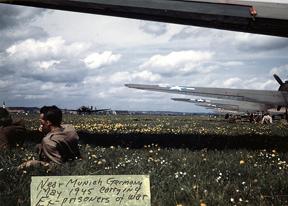
Click image for a larger view
Near Munich May 1945 Carrying Ex POWs |
Moose was flying back to
the States on one of the scheduled transports which meant that he
was limited to the amount of baggage he could carry, and also he
would not be allowed to bring back the German machine gun that was
taken from the prisoner. As a result I became the new owner of a
gun that was known as a "Burp" gun. It was nicknamed "burp"
because it would spit out about twenty rounds so fast that it sounded
like one big burp. I was able to bring this machine gun home with
me because I flew my own airplane back and customs were very kind
to us. It was illegal to own such an automatic weapon unless it
had been rendered inoperative in some manner. I traded the gun to
Dr. Walter Borg, a close friend of mine in San Antonio in 1955 when
I was transferred to the far east.
Another 310th plane piloted by Lt. Jacob Boon was struck by enemy
fire after the Polish jumped and later crashed in the drop area.
The copilot, crew chief, and |
radio operator were all wounded, but Lt. Boon
was able to crash land and get all of them out before the plane exploded.
For this heroic act he was awarded the Silver Star,
Our squadron commander,
Lt. Col. Hamby, landed at Brussels with a severely damaged aircraft
rudder and two wounded men aboard Sergeants. Harold and Combetty. A
count of holes in the airplane totaled 150.
Lt. O. J. Smith, 310th
squadron, had his crew chief, Cpl Doan and radio operator Sgt. James
wounded and bleeding profusely, so he sat down at Eindhoven to get immediate
medical attention for them. This aircraft had a damaged rudder control
and a total of 600 holes were counted.
Captain F. K. Stephenson's
plane was riddled by flak and was burning as he skillfully crashed landed
in a wooded area. Stephenson, along with his 309th crew of Lt. Garber,
Lt. Arnold, T/Sgt. Berotti, and S/Sgt. Maxwell, escaped serious injury.
C-47 no. 6132, another 309th plane, crewed by Lt. Biggs, Lt. Pearce,
Lt. Yenner, T/Sgt. Abendschoen, and S/Sgt. Herbst, burst into flames
when hit by flak and exploded as it crashed into the ground near Elst.
All were killed.
A 43rd Squadron C-47,
piloted by Lt. Cook received several hits while returning along the
Brussels corridor. He lost all hydraulic pressure and most of his fuel,
so he made an emergency landing at one of the Brussels airports. He
narrowly missed crashing into several parked airplanes and finally came
to rest against a hangar. The entire crew escaped uninjured
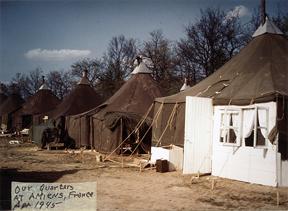
Click image for a larger view
Our Quarters Amiens France April 1945 |
I was lucky again, no serious
hits to my airplane. There were a lot of empty beds in the quarters
at Spanhoe that night. We would wait a while hoping for some good
news before we packed and stored their personnel belongings. This
was a very sad thing that we had to do from time to time, and worse
were the letters that the chaplain and squadron commander had to
write to the families. There were only three of us in the room now,
my good friends Terry Colwell, Jason Rawls, and myself.
On D+six, Sept. 23, Lt. Col. Peterson,
43rd squadron commander, led 41 aircraft to transport the 560 Polish
paratroopers and 219 parapacks that did not reach their objective
on D+four. They arrived over the drop zone "O" at 1643
hours and experienced very little ground fire. All planes returned
without damage.
|
A few days after the initial assault, a good
grass landing field had been located two miles west of the town of Grave.
With obstacles around the field removed, there were 4200 feet of usable
landing area.
The 315th sent 72 planes led by Lt. Col Lyons to transport an antiaircraft
battery and units of a Forward Delivery Airfield Group. In addition
to men, the cargo consisted of jeeps, trailers, antiaircraft guns, ammunition,
rations, gasoline, and motorcycles. We took off from Spanhoe at 1130
hours and were escorted by Mustangs and Spitfires all of the time we
were over the continent. No enemy planes got through to strike the congested
landing area. We were told that several German fighters tried to intercept
us but were shot down by our escort.
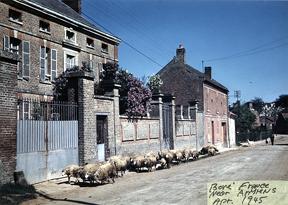
Click image for a larger view
Bore, France Near Amiens April 1945 |
After landing, the transports
were unloaded and sent off as rapidly as possible to make way for
succeeding serials to land. Two hundred and nine C-47s landed at
Grave between 1350 and 1740 hours and brought in 657,995 pounds
of combat equipment plus 882 men. Occasional ground fire was encountered
on approaches and return routes, but no 315th airplanes failed to
return from this airborne landing mission. As soon as an airplane
landed, all crew members regardless of rank jumped in to assist
with the unloading for nobody wanted to be on the ground any longer
than necessary.
The constant pressure of the German forces caused the Arnhem position
to be abandoned by the British on the night of September 25. An
estimated 1130 British and Polish Airborne troops were killed on
operation MARKET GARDEN and another 6200 were captured. |
Approximately 3500 men from the American 82nd and 101st
Divisions were listed as killed, wounded, or missing. All objectives
but the bridge at Arnhem had been achieved, but without that key bridge
over the Rhine river, the operation had failed. All troops, both Airborne
and Troop Carrier had done all they could do, but in the end, it was
not enough. Who was to blame for this failed mission was anybody's guess.
I suspect that there was enough blame to go around and then some. The
flying, the fighting, the dying was mostly done by the very young, 18
to 25 year old men who just obeyed orders from their superiors without
question. Wars must be fought by the young who are immature, naive,
and adventuresome.
The rest of Quesada's Crashed P-38 story
(below right)
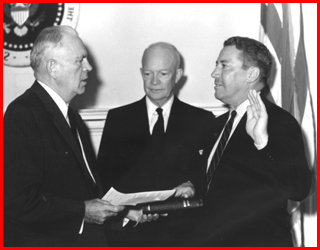 November 1, 1958 Elwood Quesada took oath
as
November 1, 1958 Elwood Quesada took oath
as
FAA first Administrator |
In 1958 Jet travel was upon us. A severe
midair collision over the Grand Canyon in 1956 spurred congress
to pass the Federal Aviation Act created the FAA as an independent
administration. National Airlines using a B-707 leased from Pan
American flew the first New York to Miami jet passenger flight,
The Federal Aviation Agency became the Federal Aviation Administration.
General Quesada became it's first administrator - the P-38 wasn't
mentioned in the ceremony.
|
|
More images
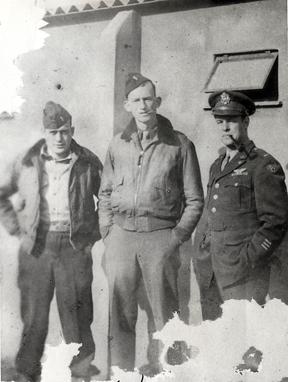
Click image for a
larger view
Larry Bassett Jr., Aubrey Ross (the author) and Terry Colwell |
|
|
| |
|
The C-47 in the background is the remains of
an airplane that was damaged very badly when it was being loaded
for the D-Day drop. A paratrooper dropped a hand grenade as he
climbed aboard killing several troops and injuring several others.
The troops that were not injured climbed aboard other aircraft
and made the drop. The airplane was so badly damaged that it declared
a total loss and the fuselage you see in the picture was used
for ditching practice.
|
Photographs by Aubrey Ross
|
More
or Market Garden right here in Kilroy Was Here:
The Sergeant Who Captured
a Division ....... Click
Here
The largest airborne operation in history?
(a quiz) ........ Click
Here
Operation Market Garden (Dutch site
translated) ........
Click
Here
PFC Joe
Mann (Medal of Honor winner at Market Garden)........Click
Here
Hall of Heroes (PFC Alfred Nigl) Glider
unit at Market Garden) ........
Click
Here
Kilroy is Here at C-47 that was there
too and still flying........
Click
Here
|

Send Corrections, additions,
and input to:
WebMaster/Editor


Click
the star for
Site Map  .. ..
|
|

